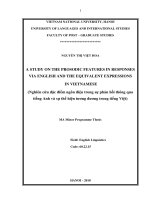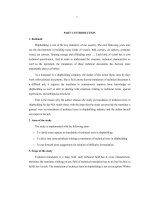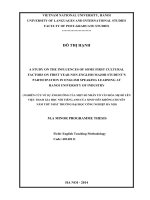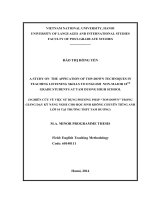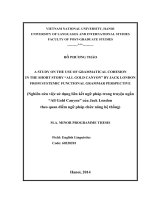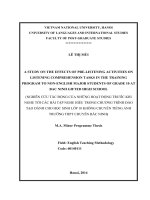A study on the prosodic features in responses via English and the equivalent expressions in Vietnamese
Bạn đang xem bản rút gọn của tài liệu. Xem và tải ngay bản đầy đủ của tài liệu tại đây (216.23 KB, 12 trang )
A study on the prosodic features in responses
via English and the equivalent expressions in
Vietnamese
Nguyễn Thị Việt Hoa
Trường Đại học Ngoại Ngữ
Luận văn ThS. Chuyên ngành: English Linguistics; Mã số: 60 22 15
Người hướng dẫn: M.A. Nguyễn Thị Bích Ngọc
Năm bảo vệ: 2010
Abstract: The study aims at prosodic features in responses via English and the equivalent
expressions in Vietnamese. This paper includes three main parts: Introduction, Development
and Conclusion. Each part is the illustration of the researcher with an aim to prove and find
out new things in linguistics. This is a kind of case study because it researches the responses
in class setting. All the contributions were collected from data of interviews and observation.
On the other hands, the thesis focuses on the analyzing of agreement and disagreement
responses between teachers and students so that intonation, speech acts were taken into
consideration. The results of the study were established in the last chapter in which all the
questions and aims were done.
Keywords: Tiếng Anh; Kỹ năng nói; Ngôn điệu; Ngữ điệu.
6
Content:
TABLE OF CONTENTS
Page
DECLARATION i
ACKNOWLEDGEMENT ii
ABSTRACT iii
TABLE OF CONTENTS iv
LIST OF SYMBOLS vii
LIST OF TABLES viii
PART A: INTRODUCTION 1
1. Rationale 1
2. Aims of the study 1
3. Scope of the study 2
4. Method of the study 2
5. Structure of the study 2
PART B: DEVELOPMENT 4
CHAPTER 1: THEORETICAL BACKGROUND 4
1.1. Sentence and Utterance 4
1.1.1. Sentence 4
1.1.2. Utterance 5
1.1.3. Response as an utterance 6
1.2. Speech Acts 7
1.2.1. Classification of speech acts 7
1.2.2. Response as an act of speech 9
7
1.3. Prosodic Features 10
1.4. Intonation 10
1.4.1. Definition of intonation 10
1.4.2. Structure of intonation 11
1.4.2.1. The falling tune 13
1.4.2.2. The first rising tune 14
1.4.2.3. The second rising tune 14
1.4.2.4. The falling rising tune 15
1.4.3. Functions of intonation 15
1.4.3.1. The attitudinal function 16
1.4.3.2. The accentual function 16
1.4.3.3. Grammatical function 16
1.4.3.4. The discourse function 17
1.5. Summary 17
CHAPTER 2: METHODOLOGY 18
2.1. Context setting 18
2.2. Participants 18
2.3. Data collection 19
2.4. Research questions 19
2.5. Data analysis framework 20
2.6. Summary 20
CHAPTER 3: FINDINGS 21
3.1. Findings 21
3.1.1. Differences in responses between teachers and students 21
3.1.2. Agreeing samples via English and equivalent expressions in Vietnamese 22
3.1.2.1. Teacher towards students 23
3.1.2.2. Students towards teacher 24
8
3.1.3. Disagreeing samples via English and equivalent expressions in Vietnam 26
3.1.4. The functions of intonation in responses 27
3.1.4.1. Intonation of agreement 28
3.1.4.1.1. The attitudinal function 28
3.1.4.1.2. The accentual function 29
3.1.4.1.3. The discourse function 30
3.1.4.1.4. Grammatical function 31
3.1.4.2. Intonation of disagreement 32
3.1.4.2.1. The attitudinal function 32
3.1.4.2.2. The accentual function 33
3.1.4.2.3. The discourse function 33
3.1.4.2.4. Grammatical function 34
3.2. Summary 34
PART C: CONCLUSION 35
1. Recapitulation 35
2. Limitations and suggestions for further study 36
REFERENCES 37
APPENDIX 1. I
9
LIST OF SYMBOLS
1. Symbol of stress: '
2. Symbols of intonations
- The glide down:
- The glide up:
- The take - off:
- The Dive:
3. Tonic syllable: Underlined part in an utterance.
4. Utterance is pulled:
10
LIST OF TABLES
Table Page
Table 1. Agreeing samples of teachers towards students 23
Table 2. Agreeing samples of students towards teachers 25
Table 3. Disagreeing samples of teachers towards students 27
11
PART A: INTRODUCTION
In this part, the rationale which explains the reasons for choosing this topic, the
aims of the study which illustrates typical goals, the scope of the study which narrows
down the research scale and the structure of the study which builds up a frame are
established clearly.
1. Rationale
Prosody plays an important role in communication. Through prosody, people can
express their emotion state or sentiment tone. People can use prosody to show their
attitudes such as happiness, sadness, anger, love or hate. However, during communicative
process, it is easy to recognize that many speakers cope with problems in using prosody.
They sometimes do not know exactly how to use prosody in speaking and even in some
cases not understand the real meaning of utterances from speakers. Consequently,
understanding and choosing suitable prosodies will fill in the gaps in communication.
Moreover, choosing fitted prosodic features is necessary because this will help
speakers in reaching their aims in communication. For example, speakers may raise their
tone at the end of the utterance in asking instead of using question words as in: ''While the
teacher is teaching, students can talk''.
One more reason for choosing responses as the topic of the study is that response is
a factor in communication that helps speakers or hearers go on the conversation, depending
on the way they response to the others.
We hope that the study not only contributes a small part in the success of each
conversation but also can be considered as the ground stage for further researches.
2. Aims of the study
Due to the study is limited in the context of classroom in general and prosodic
features in responses between the teachers and students in particular as stated in scope of
the study, therefore, the goals of the study are as follows:
* To find out the similarities and differences in the responses between teacher and
students in context of a class.
* To look at the way how teachers and students express their responses showing
agreement and disagreement in classroom context.
12
* To find out the prominent intonation strategies preferably used in agreeing and
disagreeing responses by teacher and students.
3. Scope of the study
The study investigates responses in the level of speech acts. There are many kinds
of responses such as responses to a letter, responses to a question, responses to an
invitation and so on. Nevertheless, this study focuses on responses of teachers and students
in showing agreements and disagreements. In addition, the study examines chiefly
prosodic features in which intonation in utterances will be paid attention.
Moreover, due to the limitation of time, ability as well as knowledge, the research
context chosen is in English classes in grade 11 at Ischool Hatinh where the researcher
observes and describes mostly the actions and responses between teacher and students.
4. Method of the study
The study bases on quantitative research, which is to determine the relationship
between one thing and another. Quantitative research designs are either descriptive or
experimental, which means that we use personal observation and facts to form general
rules.
The participants of the study include teacher and students at Ischool Hatinh high
school.
5. Structure of the study
The study is divided into three main parts: Introduction, Development and
Conclusion.
Part A. Introduction:
As many other studies, this part introduces briefly the rationale, aims, the scope,
methods and organization of the study.
Part B. Development
This part includes three chapters:
* Chapter 1: Theoretical background
This is an overview of the related theories. It also concerns the previous works and
issues on speech acts and prosodic features. In each part, there are many sub-terms that
explain Speech Acts theory, sentence and utterance, similarities and differences in the
13
responses between teacher and students, response as an utterance, definition of intonation,
structures and functions of intonation.
* Chapter 2: Methodology.
This chapter introduces quantitative method as the main method for the research. In
particular, it describes the research questions, participants, data collection and data analysis
framework.
* Chapter 3: Findings
This chapter presents findings on intonation in agreeing and disagreeing responses
of teacher and students in class context.
Part C. Conclusion
The last part will summarize the over all of the study and provide limitation and
suggestions for further study.
44
REFERENCES
Vietnamese:
1. Diệp Quang Ban (1996), Ngữ pháp tiếng Việt. Tập 2-Nhà xuất bản giáo dục.
2. Đỗ Hữu Châu (1995), Giáo trình giản yếu về ngữ dụng học, Nhà xuất bản giáo dục.
Huế.
3. Đỗ Hữu Châu & Bùi Minh Toàn (1993), Đại cương ngôn ngữ học. Tập 2. Nhà xuất bản
giáo dục
4. Nguyễn Hòa (1999), Lực ngôn trung và các kiểu câu, trong những vấn đề ngữ dụng học
kỷ yếu Hội thảo khoa học "ngữ dụng học " lần thứ nhất Hà Nội. Nhà xuất bản Khoa
Học Xã Hội Hà Nội
5. Nguyễn Huy Kỷ (2006), Ngữ điệu tiếng Anh ở người Việt. Nhà xuất bản Văn hóa thông
tin.
6.Nguyễn Quang (2009), Cú điển dụng Anh-Việt. Nhà xuất bản Từ điển bách khoa
7. Võ Đại Quang (2009), Một số phương tiện biểu đạt nghĩa tình thái trong tiếng Anh và
tiếng Việt. Nhà xuất bản Đại học Quốc gia Hà Nội
8. Lê Quang Thêm (2004), Nghiên cứu đối chiếu các ngôn ngữ. Nhà xuất bản Đại học
Quốc gia Hà Nội.
9. Trần Ngọc Thêm (1997), Cơ sở văn hóa Việt Nam. Nhà xuất bản giáo dục.
English:
1. Arne Vanvik et al. (1979), English Intonation. CUP.
2. Austin, J. L. (1962), How to Do Things with Words. CUP. London-Oxford-New York
3. Backmann, N. (1997), Learner Intonation: A pilot study in CA. Henning (Ed),
Proceedings the second language research forum.
4. Brown, P., Levison, S. (1987), Politeness: Some Universals in Language Usage. CUP
5. Brown, P and Yule, G. (1989), Discourse Analysis. CUP
6. Checketts, S. (1993), Thoughts on Pronunciation. New Straits Times,
7. Cook, G. (1989), Discourse. London: Oxford University Press.
8. Crystal, D. (1980), A First Dictionary of Linguistics and Phonetics. Boulder, CO: West
view.
45
9. Crystal, D. (1991), A Dictionary of Linguistics and Phonetics. 3rd edition. Cambridge,
MA: Basil Blackwell.
10. Ericsson, K. & Simon, H. (1987), Protocol Analysis. Cambridge, MA: MIT Press.
11. Fromkin, V and Rodman, R. (1998), An Introduction to Language. Harcourt Brace
College Publishers.
12. Fromkin and Rodman, R. (1993), An Introduction to Language. New York : Holt,
Rinehart, and Winston
13. Goshgarian, G. (1995), Exploring Language. London: Oxford University Press.
14. Halliday, M. A. K. (1992), Spoken and Written Language. London: Edward Amorl.
15. Halliday, M. A. K. (1992), Spoken and Witten Language. London: Edward Amorl.
16. Hartmann, R.R.K., F.C. Stork. (1972), Dictionary of Language and Linguistics.
London: Applied Science.
17. Hawkins, P. (1984), Introducing Phonology. London : Hutchinson
18. Hurford, J. R, Heasley. B. (2003), Semantics a Course Book. New edition. Cambridge
University Press.
19. Jonhson, D. M. (1987), The Organization of Instruction in Migrant Education:
Assistance for Children and Youth at Risk . TESOL Quarterly. Chapter 4.
Approaches to Research in Second language learning.
20. Juliah, M. B. (1993), Stress and Meaning: Malay UKM Students’ Ability to Apply
English Wrd Stress. Academic exercise. University Kebangsaan Malaysia.
21. Ladefoged, P. (1982), A Course in Phonetics. San Diego: Harcourt Brace Jovanovich.
22. Leech, G. (1983), Principles of Pragmatics. London: Longman.
23. Levinson, S. (1983), Pragmatics. Cambridge: Cambridge University Press.
24. O'Connor, J. D. & Arnold. (1973), Intonation of Colloquial English. London: Longman
25. Phuong, Nguyen Thu. (2007), An Investigation into Some Types of Verbal Responses to
Questions in English and Vietnamese Conversion. MA thesis. Vietnam national
university.
26. Quang,Vo Dai & Tam, Ha Cam. (2009), English Phonetics and Phonology. Hanoi.
46
27. Richards, J. C., Platt, J., Platt, H. (1992), Dictionary of Language Teaching and
Applied Linguistics (second edition). London: Longman
28. Richards, J. C., Platt, J., Platt, H. (1985), Dictionary of Language Teaching and
Applied Linguistics. London: Longman
29. Richards, J. C., Platt, J., Platt, H. (1992), Dictionary of Language Teaching and
Applied Linguistics (second edition). London: Longman
30. Roach, P. (1988), English Phonetics and Phonology: a Practical-Course (7th Ed.).
Cambridge : Cambridge University Press.
31. Searl, J. R. (1976), Speech Acts. Cambridge, England. OUP
32. Searle, J. R (1976), “Indirect Speech Acts”, in Cole, P. and Morgan, J. (eds.): Syntax
and Semantics 3: Speech Acts. New York: Academic Press.
33. Sit, Hoang Van. (1980), Tone in Modern Vietnamese. MA thesis. University of Sydney
34. Tam, Dao Thi. (2007), Contrastive Analysis of Intonation in English Yes-No Questions
and Vietnamese Equivalent Expressions. MA thesis. Vietnam national university.
35. Tench, P. (1996), The Intonational System of English. New York: Wellington House
36. Thomson, D. (1996), Second Language Acquisition. PPP-ITM : Mass Lecture.
37. Wierzbicka, A. (1987), English Speech Acts Verbs- A Semantic Dictionary Academic
Press Australia.
38. Yule, G (1996), Pragmatics. Oxford: Oxford University Press.
Websites:
1.
2.
